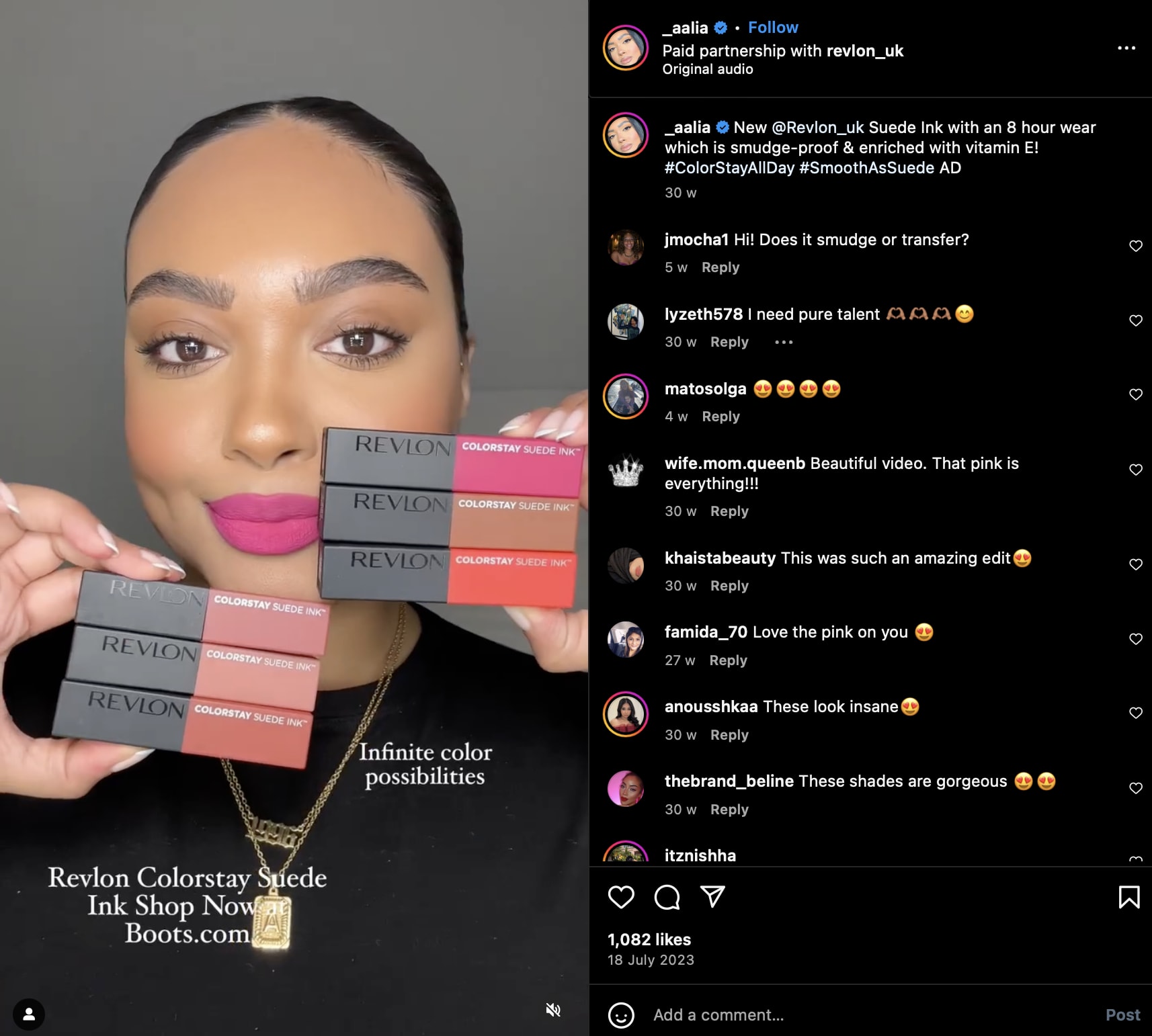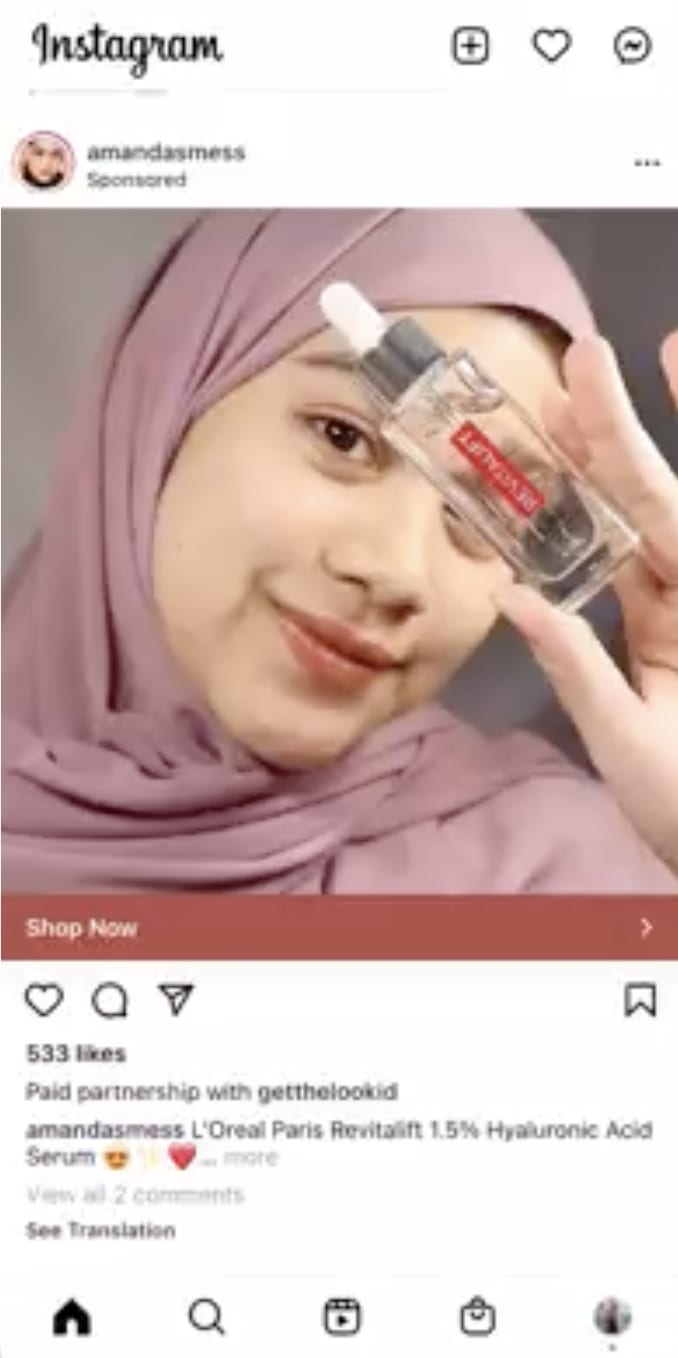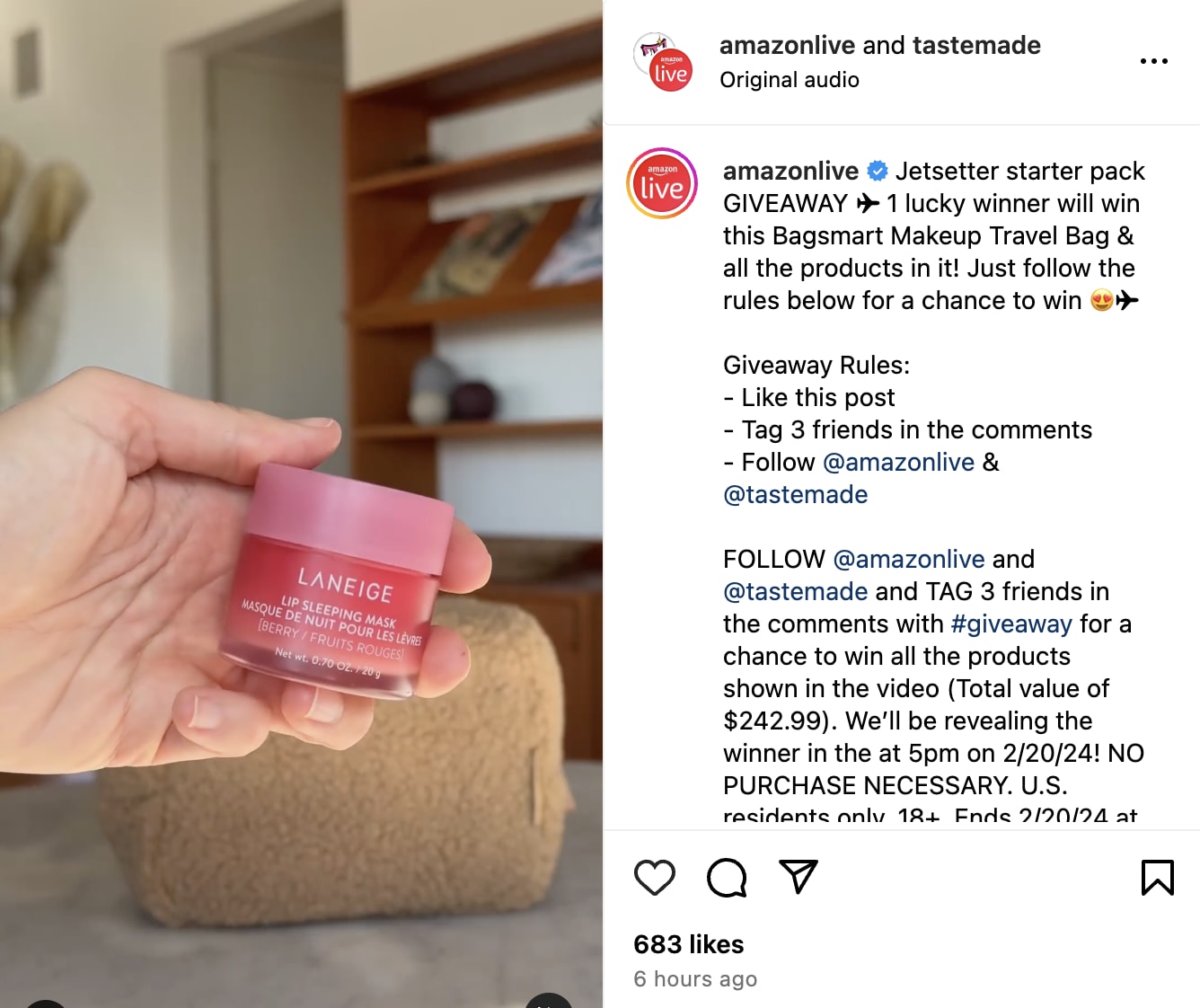Influencer Marketing Costs: Prices Guide for 2024
Influencer marketing costs vary, ranging between $1k to $500k for campaigns. Or as little as $20 for one image post. We break down the costs by type of influencer, content, and platform. Examples included.
 March 24, 2024
March 24, 2024 14 minute reading
14 minute reading
There’s never been a greater demand for influencer marketing. It’s a $24 billion industry in its own right and a standard line item in 26% of marketing agencies and brands’ advertising budgets.
But many business owners struggle with determining how much to budget or spend on influencer marketing to find new customers and drive sales.
Based on average costs, brands spend about $214 per influencer. A simple influencer marketing campaign can cost anywhere between $1,000 to $10,000, while large, comprehensive campaign budgets can range from $10,000 to $500,000, or more.
To put these numbers into perspective, we’ll break down the influencer marketing costs based on the influencer and content type, platform choice, and type of influencer partnerships.
Find an influencer marketing expert on Fiverr
How much does influencer marketing cost?
Influencer marketing costs vary, ranging between $1,000 for a simple campaign to $500,000 for a large, more comprehensive campaign. Or as little as $20 for one image post.
Let’s start with reviewing the average price you can expect to pay per influencer, platform, and content type.
Influencer marketing services costs by platform
Instagram influencer pricing
Average cost per Instagram post
Nano influencer: $20-$100
Micro influencer: $35-$450
Mid-tier influencer: $150-$2,500
Macro influencer: $350-$7,000
Mega influencer: $1,200+
Average cost per Instagram Reel
Nano influencer: $100-$200
Micro influencer: $200-$1,000
Mid-tier influencer: $1,500-$5,000
Macro influencer: $5,000-$7,000+
YouTube influencer pricing
Average cost per video
Depending on the audience size, length of video, and campaign scope, you can expect to pay influencers the following rates for sponsored YouTube videos:
Nano influencer: $60-$850
Micro influencer: $180-$3,000
Mid-tier influencer: $400-$6,000
Macro influencer: $1,100-$20,000
Mega influencer: $2,500+
TikTok influencer pricing
Average cost per post
Nano influencer: $20-$150
Micro influencer: $30-$400
Mid-tier influencer: $80-$1,650
Macro influencer: $150-$3,500
Mega influencer: $1,200+
Facebook influencer pricing
Average cost per post
Nano influencer: $25-$250
Micro and mid-tier influencer: $250-$1,250
Macro influencer: $25,000
Mega influencer: $25,000+
Influencer marketing services costs by type of influencer
As a rule of thumb, you can calculate an influencer’s rates per post based on their follower count and niche or industry. Here’s a breakdown of the average costs per sponsored post based on the type of influencer:
Nano influencers (<10,000 followers): $25-$1,105
Micro influencers (10,000-60,000 followers): $109-$1,674
Mid-tier influencers (60,000-200,000 followers): $481-$3,396
Macro influencers (200,000-1 million followers): $949-$4,992
Mega influencers (Over 1 million followers): $1,694-$5,497
An influencer’s payment terms may also impact their rates. Influencers who work for a fee, for instance, offer multiple payment options based on your campaign, such as the number of posts, clicks, subscribers, or acquisitions.
Influencer marketing services costs by type of content
Influencers create different types of content: videos, image posts, stories, and Reels. Here’s a breakdown of the average costs per content type:
Video (TikToks, Reels, and Stories)
Average cost per video
Nano influencer: $25-$250
Micro and mid-tier influencer: $250-$1,250
Macro influencer: $25,000
Mega influencer: $25,000+
Image posts
Average cost per image post:
Nano influencer: $55-$100
Micro influencer: $100-$175
Mid-tier influencer: $175-$625
Macro influencer: $625-$1,000
Mega influencer: $1,000+
Ultimately, your average influencer marketing costs vary based on your goals and metrics aligned to your campaign. Go with influencers who get you the best performance and value for the money.
“I’d suggest marketers trying to run an effective influencer campaign to invest at least $100K,” says Denise Vitola, a digital and influencer expert. “With that, you can hit high awareness, purchase KPIs, and even buy the rights to use content in paid and outside influencer channels.”
What factors impact the price of influencer marketing?
Influencer rates vary depending on:
Type of influencer
Type of content
Platform choice
Type of influencer partnership
Let’s break down these factors and how they impact influencer marketing costs.
Type of influencer
There are different types of influencers with niche audiences on various online channels. Here’s a rundown of influencer types based on audience size.
Nano influencers
These are small influencers with fewer than 10,000 followers. They’re often experts in a specialist field, like gardening, pottery, or holistic health, and share posts with a close-knit community.
Some nano influencers collaborate with brands in exchange for products or experiences, like invitations to events. Like Bobbi-Nicole Applegate, a nano influencer with over 5,000 followers on Instagram who collaborated with Coca-Cola for its #cokeambassador campaign.

Source: Instagram
Micro influencers
These influencers have between 10,000 and 60,000 followers on different social media platforms.
It’s a popular segment, with 64% of brands preferring to work with them owing to the authentic connection they build with their audience, their high engagement levels, and greater return on investment (ROI).
Take Pupford, for example. The pet services brand partners with micro influencers, like Elise Hurley of the @pearlthegoldenpup profile on Instagram, Facebook, YouTube, and TikTok, to promote its products and highlight their benefits.

Source: Instagram
Like nano influencers, micro-influencers can also include up-and-coming creators or big players in a smaller niche or competitive markets. They offer a ‘sweet spot’ between reach and engagement, but are more affordable than mid-tier, macro, and mega influencers.
“On one hand, micro-influencers range from providing free products to $100-$250 per story post and $500 for an in-feed post,” says Josh Weaver, senior brand and social media strategist at Ad Leverage.
Mid-tier influencers
Mid-tier or mid-sized influencers are more well-known and established in their industry than micro-influencers. Plus, they have 60,000 to 200,000 followers, which attracts brands interested in increasing reach over engagement.
“For brand awareness campaigns where "the most eyeballs possible" matters most, using an A-list creator or top-tier influencer can run around $25k-$50k depending on the deliverables (number/type of posts) provided,” says Weaver.
These influencers generate a sizable income from sponsored content and brand partnerships in broader categories, like food, fitness, beauty, and lifestyle.
For example, Revlon, Supergoop, Huda Beauty, and other beauty brands partner with Aalia, a London-based makeup artist, on content creation projects in the skincare and beauty niche.

Source: Instagram
Macro influencers
Macro influencers have between 200,000 and 1 million followers and tend to be a mix of savvy content creators and B-list celebrity influencers who have grown their follower count through engaging content.
This group of influencers can negotiate brand deals and partnerships worth a lot more money than nano, micro-, and mid-tier influencers.
HelloFresh, for example, partnered with fitness influencer James Doyle who has over 1.2 million TikTok followers.

Source: TikTok
Mega influencers
This is the most expensive group of influencers with over 1 million followers. They can command millions of dollars per post and brands often partner with them to boost reach for large campaigns.
For example, Lunchables recently partnered with mega-influencer Zach King, who has over 80 million followers, to promote its Lunchabuilds limited edition building kits.

Source: TikTok
Type of content
Influencers need to spend time, money, creativity, and effort creating content based on your needs.
Prices will fluctuate depending on the type of content you want them to create, as different types of content will require different things, such as filming gear, software, props, and additional actors.
Linktree Creator report shows 36% of creators take between 1 and 5 hours making content each week. The more effort an influencer takes to create your content, the higher the pricing will be. For example, creating an image may take less time compared to video content, which requires planning, effort, equipment, and time.
Besides the type of content, there are other factors that impact the influencer pricing, including:
Number of posts
Posting frequency
Content usage or ownership rights
Rush fee to expedite your campaign
Exclusivity clauses
Platform choice
Before settling on a price, consider the number of platforms you want the influencer to create content for. For instance, do you want them to post on one platform or a mix of content for multiple platforms?
The top influencer marketing platforms for packaging brand partnership deals are:
Instagram
TikTok
YouTube
Facebook
Instagram influencer costs
Instagram offers an authentic, casual platform for influencers to recommend products or services through feed posts, Instagram Stories, or Reels. It’s popular with nano- and micro-influencers, who enjoy solid engagement rates on the platform, while 30% of marketers say they get the biggest influencer marketing ROI from Instagram.
Tapping into influencers’ audiences on Instagram can boost your brand awareness and engagement rates. You can do this through different types of influencer partnerships, like a collab post, which allows you to co-author posts and Reels with influencers.
Here’s an example of a collab post between Drew Michael Scott (@lonefoxhome)—a mid-tier influencer—and Pottery Barn:

Source: Instagram
The cost of influencer marketing on Instagram can fluctuate depending on the type of influencer and content, and the scope of your campaign.
Later’s Creator Rates report, shows influencers charge a baseline fee of $100 to $7,000+ for a single Instagram Reel, while a single post could cost you anywhere from $10-$10,000.
“In my experience, for Instagram, you may pay anywhere from $300 to $3,000 per post for micro- to mid-tier influencers,” says Joe Amaral, founder of Elevated Marketing Experts. “These influencers can offer a highly engaged audience, often leading to a more intimate and impactful promotion of your product or service.
Haiko de Poel, owner of Mass Impact digital agency and former fractional marketing manager adds:
“On Instagram, emerging micro-influencers might charge anywhere from $250 to $500 per post, given their highly engaged but smaller audience,” Poel says. “Meanwhile, more established influencers with broader reach can easily command $5,000 to $10,000 per post, depending on their follower count and engagement levels. Consider the nature of the content; a simple story shoutout may cost less than a dedicated post or a series of posts that involve more creativity and production costs.”
TikTok influencer costs
TikTok is a popular influencer marketing channel where brands are turned into trusted online names.
Whether you’re starting or running an established enterprise, tapping into TikTok influencer marketing is a no-brainer. In fact, the platform is poised to become the largest in total daily minutes by 2025, making it the perfect platform for targeted influencer marketing campaigns. But that comes at a cost.
Like other social media channels, TikTok influencer rates fluctuate based on the type of influencer and content, engagement rate, and the length of the agreement.
Star Kashman, a TikTok influencer and award-winning cybersecurity and privacy law expert with over 85,000 followers, bases her rates on her niche, type of post, and number of followers:
“I may charge $650+ because I have a bigger and more active audience there,” says Kashman. “TikTok has the best business potential for brands, and TikTok content takes more time and energy to create as they are cleanly edited short-form videos. For solopreneurs, friends, and those with fewer resources, I really try to support them by creating content in exchange for products they want to be featured. Typically, I’ve charged $450-$650 for feed posts and video posts for my audience when I was actively influencing.”
Amaral adds that TikTok influencer marketing costs can range from $400 for nano influencers up to $5,000 for mega influencers with millions of followers and viral content potential.
YouTube influencer costs
Fifty-eight percent of marketers use YouTube for influencer marketing. The platform’s 2.49 billion users make YouTube a leading platform for marketers to reach new audiences. You can also access YouTube BrandConnect to find the right influencer for your next campaign.
Plus, you can publish long-form and short-form YouTube videos on a wide range of topics through influencers. One of the popular YouTube influencer marketing examples is unboxing videos. It’s a simple, cost-effective, and easy way to give viewers an authentic first impression when opening and experiencing a brand’s product for the first time.
Here’s a prime example of Insta360’s partnership with Lewis Hilsenteger of Unbox Therapy tech review channel:

Source: YouTube
YouTube charges range from a few hundred to thousands of dollars, depending on the type of influencer and content. However, prices go up significantly for macro and mega influencers with millions of followers and high engagement levels.
But some brands, like SportingSmiles, prefer to pay based on influencer content performance and give deliverables or milestones to accomplish per campaign.
“We pay based on views and have milestones for each influencer,” says Seth Newman, Vice President of SportingSmiles. “For every 50,000 views, we will pay $250. The influencer needs to establish themselves first with our brand, as we do some test runs to make sure their content is viable for us. The test runs typically mean we give them free products first and see if there is interest from their audience by giving them a coupon code.”
Facebook influencer costs
Instagram and TikTok may be ahead of Facebook in the influencer marketing space, but it remains the biggest social platform in the world with over 3 billion users to boot. And, 68% of consumers use Facebook, compared to YouTube (61%), Instagram (40%), and TikTok (31%). So, it’s still relevant in any influencer marketing strategy.
Besides working with influencers, Facebook lets you run branded content and collaborative ads to expand your reach to a diverse, broad-based target group. You’ll not only scale your campaigns, but you’ll also deliver personalized experiences to your target audience.
Global beauty brand, L’Oréal, used Facebook influencer marketing to promote a new serum product in Indonesia. The campaign featured content from 15 influencers using the serum, messaging about how it hydrated their skin, and implementing a call to action (CTA) encouraging people to try the product for themselves.

Source: Instagram
Then, L’Oreal promoted the influencers’ posts as branded content ads in Stories and in-feed labeled as paid partnerships, plus Collaborative Ads linking directly to L’Oreal’s Shopee store. The results: 48% lift in content viewed, 10% lift in purchases, and 41% lift in add-to-cart actions.
Like other platforms, Facebook influencers’ rates will vary based on the follower count, content type, and engagement. Ryan Carrigan, CEO and founder of moveBuddha estimates the rates to be between $500 to $6,000 per posting.
If your influencer marketing campaign involves a mix of two, three, or all of the above channels, you’ll likely pay differently for each platform, but you’ll engage a wider audience and maximize your reach.
Type of influencer partnership
There are several formats influencers use to engage their audiences on different platforms. Let’s review the most popular types below.
Sponsored content
Sponsored content refers to dedicated posts featuring a brand’s products or services. You can pay social media influencers to create content around your brand and its offerings and post to one or more of their pages.
These posts are often labeled as “sponsored content”, “paid partnership”, or “paid content” or have the #ad hashtag in the caption, like this example of Darwin Pet Food’s collaboration with @chaosinthedesert.

Source: Instagram
The cost of a sponsored post varies depending on the type of influencer and content, niche or industry, engagement rate, and other factors. Typically, you can expect to pay anywhere from $10 to $30,000+ per post.
Giveaways
Giveaways are another great influencer marketing tactic, especially if you want to reach new audiences and boost engagement. You can collaborate with an influencer and give away a newly launched product to drive awareness.
AmazonLive collaborated with Tastemade in a giveaway where one lucky winner gets to win a Bagsmart Makeup travel bag and several other products.

Source: Instagram
Each brand and influencer has a unique combination of content needed for a giveaway, which will determine the eventual costs. For example, if you want three photo posts and a Reel to promote your giveaway, calculate the costs per photo post and a single Reel to get a ballpark figure.
Giveaways are usually short-term and generate interest, provide value to the brand and influencer, and increase brand awareness and leads.
Need help planning and hosting a giveaway? Turn to Fiverr’s social media marketing experts to create and execute the perfect giveaway.
Affiliate marketing
Affiliate marketing is a popular way for influencers to earn commissions from their digital marketing efforts on behalf of brands.
Here’s how this type of influencer partnership works:
Influencer signs up for a brand’s affiliate marketing program
Brand gives the influencer an affiliate link—a URL with a unique, trackable ID
Influencer posts the link in their social media profile bios and/or posts
Potential customers click on the affiliate link
The brand attributes the link to the affiliate (influencer) and records the source of traffic and conversions
Influencer (affiliate) gets a commission on each sale from their affiliate link
For example, Valerie Sanders’ bio link is a tracked affiliate link that directs potential buyers to Poshmark. When someone completes a purchase through that link, Sanders makes a commission (percentage of the order or item).

Source: TikTok
Influencers who use affiliate marketing charge based on clicks or sales, so numbers vary based on the product or service they’re promoting.
Shoutouts
A shoutout involves an influencer mentioning a brand on their social media posts, Reels, Stories, TikToks, or YouTube videos with or without visuals. Shoutouts leverage the influencer’s authority and reach, helping brands boost visibility and credibility. They can also be used for CTAs to increase sales and traffic.
Mentions
Mentions, like shoutouts, involve an influencer mentioning a brand in a comment and charges for the mention based on their audience size. Done well, a mention can boost a brand’s website traffic, sales, and customer loyalty.
Takeovers
A takeover is when an influencer “takes over” a brand’s social media account to curate and post content on its behalf for a specified period.
During a takeover, influencers provide valuable real-life context of using a brand’s products or services to humanize and make it more relatable to its target audience.
Takeovers can also increase engagement and give existing customers and new audiences a unique perspective of a brand.
Peter Garritano, for example, took over New Yorker Photo’s Instagram page. Garritano promoted the takeover on his account to build awareness before it happened and shared pics from his latest project.

Source: Instagram
Gifts or product seeding
Product seeding is when a brand sends various prominent influencers their products, hoping they’ll say something positive about them. This type of influencer marketing works well with nano- and micro-influencers compared to those with larger followings.
Brand ambassadorship
This is a longer type of influencer marketing engagement, where a brand reaches out to an influencer and negotiates a discounted rate for a long-term agreement.
Brand ambassadorships work best when an influencer already uses the brand’s products or services and shares photos, videos, or posts over a long period, becoming the face of the brand.
For example, Calvin Klein took BTS pop star Jungkook as one of its global brand ambassadors for the company’s spring 2024 campaign.
Work with influencer marketing experts
Influencer marketing can feel daunting, especially if you’re just getting started or lack the time and knowledge to implement it.
Given the growing importance of influencer marketing for businesses, it pays to have yours taken care of by skilled professionals in the industry.
Luckily, experts are within reach thanks to Fiverr. Here, you can find a wide range of talented influencer marketing professionals who can plan your strategy, build your influencer marketing plan, and execute everything within your influencer marketing budget.
Sign up to Fiverr today to find and hire expert talent and tap into the robust power of influencer marketing.
